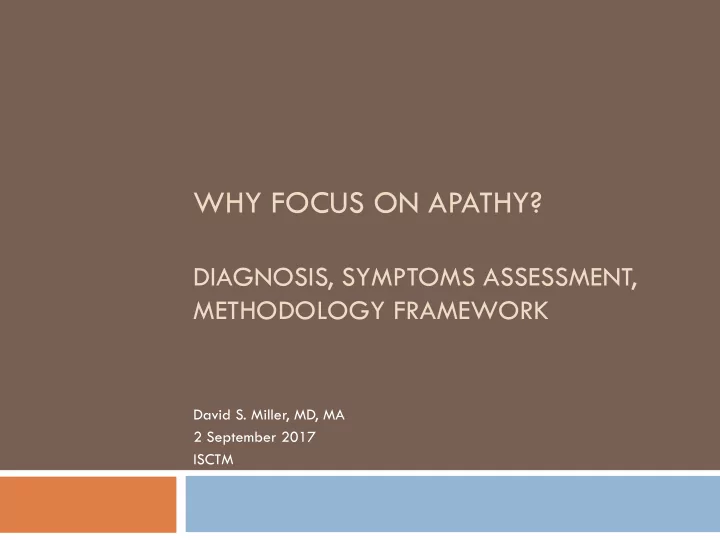

WHY FOCUS ON APATHY? DIAGNOSIS, SYMPTOMS ASSESSMENT, METHODOLOGY FRAMEWORK David S. Miller, MD, MA 2 September 2017 ISCTM
ALTERNATE TITLE: WHO'LL STOP THE TRAIN? David S. Miller, MD, MA 2 September 2017 ISCTM
Disclosure I am a full-time employee of Bracket
Addressing this Issue In the context of both the NPS-PIA and ISCTM BPSD Working Group
Estimated Prevalence of Apathy 2-5% in Cognitively Normal Persons 15-43% in MCI 36-51% in Mild AD 36 – 72% in AD (mild – severe)
Mild Behavioral Impairment (MBI) Construct developed by the NPS-PIA Acquired in late life Sustained Impactful Can present in advance of any cognitive impairment or along with MCI APATHY is one of these symptoms
Apathy’s Impact Leads to impairment in both ADLs and iADLs Causes increased caregiver burden Is associated with poorer prognosis Can result in increased mortality
IMAGINE… Subway Commuter train/Acela TGV, Frecciarossa, Shinkansen You have a symptom that Heralds pending cognitive impairment Speeds the progression from NL cognition -> MCI -> Dementia diagnosis Results in significant caregiver distress Would you try to address it/treat it/slow or stop the train?
“A” Distinction A pathy A nhedonia A motivation
As the field has evolved Definition of apathy operationalized Scales developed to assess apathy (and other NPS) in dementia Diagnostic criteria for apathy established Improved understanding of the etiology and subtypes
Diagnostic Criteria for apathy in AD 11 Core feature of apathy, diminished motivation, A. present x ≥4 weeks 2/3 dimensions of apathy, reduced B. goal-directed behavior, goal-directed cognitive activity emotions functional impairments attributable to apathy C. exclusion criteria are specified to exclude D. symptoms and states that mimic apathy Inter-rater reliability high (kappa 0.93, p=.0001) Robert et al 2009, Mulin et al 2011
So, why the apathy re apathy? At the time of abstract submission – a search of “apathy and dementia” on clinical trials.gov revealed only 11 studies And, how many were pharma initiated?
How many??? NONE
And, they varied a great deal Essentially, all were run by academic investigators Interventions included stimulants (modafinil and methylphenidate, ) dextromethorphan, rivastigmine, rTMS, computerized training MMSEs as low as 10 Varying apathy severity Varying apathy criteria (NPI, AES, AES-C, FrSBe) Varying outcome measures (NPI, AES, AES-C, CGIC, FrSBe, Apathy Inventory, TUG, LARS, Reaction time on computerized cognitive testing, Motricity)
Can Pharma Trials be Done? YES Use Established Diagnostic Criteria Acknowledge the subtypes Carefully select outcome measure(s) Evaluate apathy alone or in combo with other NPS (eg – depression)? Incorporate Neuroimaging and Biomarkers Consider pharmacologic challenge Address issues around placebo response Standardize Non-Pharmacologic Interventions Appreciate the source for determining ratings
Psychosocial interventions What were they and how often? How are those delivering the psychosocial therapies trained and vetted? Is the intervention standardized? Is the delivery of the intervention monitored? Are the therapies monitored for uptake, quality of implementation, and effect? If so, how? Is there any difference if the “caregiver” lives with the subject or not? Any impact on how they utilize and/or report on the outcome of the intervention(s)?
Data Quality Programs Identify and significantly reduce rater errors over the course of the trial eCOA improves standardization & further reduces errors Addition of audio reviews enhances ability to identify and remediate administration &/or scoring errors
ALL ABOARD??? The train is leaving the station…
Apathy: Diagnostic Criteria Robert, P et al. Eur Psychiatry 2009. 24 (2): 98-194 Diagnosis requires fulfillment of criteria A, B, C and D A. Loss of or diminished motivation in comparison to the patient’s previous level of functioning and which is not consistent with his age or culture. These changes in motivation may be reported by the patient himself or by the observations of others A. Presence of at least one symptom in at least two of the three following domains for a period of at least four weeks and present most of the time Domain B1 – Behavior Domain B2 – Cognition Domain B3 – Emotion Loss of, or diminished, goal-directed Loss of, or diminished, goal-directed cognitive Loss of, or diminished, emotion as evidenced by behavior as evidenced by at least one of the activity as evidenced by at least one of the at least one of the following: following: following: Loss of self-initiated behavior (e.g., Loss of spontaneous ideas and curiosity for Loss of spontaneous emotion, observed or self- in starting conversation, doing basic tasks routine and new events (i.e., challenging tasks, reported (e.g., subjective feeling of weak or of day-to-day living, seeking social recent news, social opportunities, absent emotions, or observation by others of a activities, communicating choices) personal/family and social affairs). blunted affect) Loss of environment-stimulated behavior Loss of environment-stimulated ideas and Loss of emotional responsiveness to positive or (e.g., in responding to conversation, curiosity for routine and new events (i.e., in the negative stimuli or events (e.g., observer- participating in social activities) person’s residence, neighborhood or reports of unchanging affect, or of little community). emotional reaction to exciting events, personal loss, serious illness, emotional-laden news)
Apathy: Diagnostic Criteria cont’d A. These symptoms (A & B) cause clinically significant impairment in personal, social, occupational, or other important areas of functioning A. The symptoms (A & B) are not exclusively explained or due to physical disabilities (e.g. blindness and loss of hearing), to motor disabilities, to diminished level of consciousness or to the direct physiological effects of a substance (e.g. drug of abuse, a medication)
Recommend
More recommend